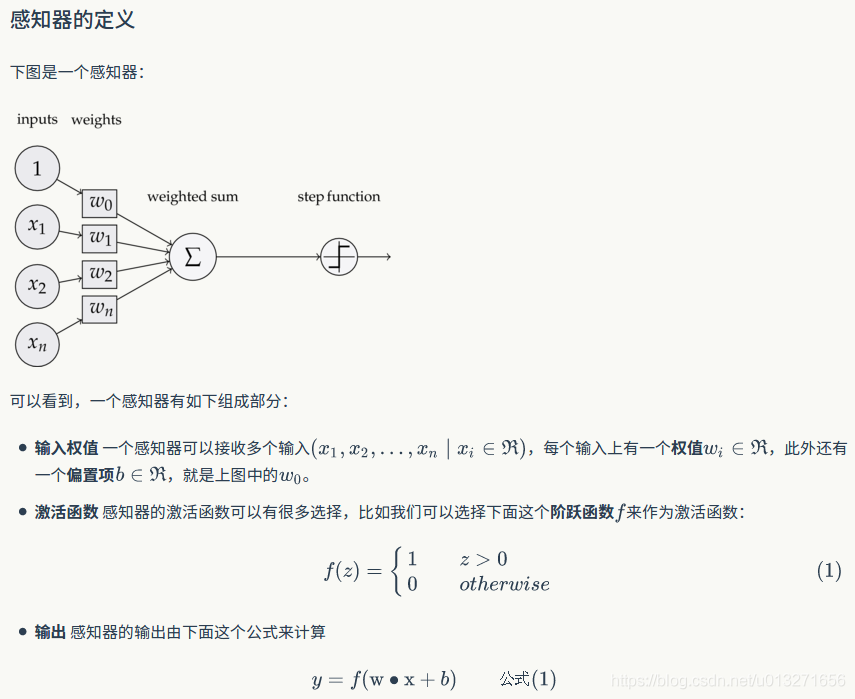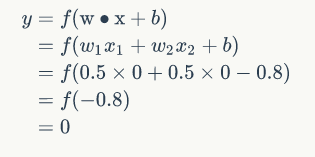学习神经网络,顺便记个笔记。
若转载,请贴 https://blog.csdn.net/u013271656/article/details/101373902
1. 感知器_MLP
本文参考链接中大佬写的文章,通俗易懂。感知器(MLP介绍以及python代码):
贴一下MLP介绍:

接下来将介绍如何用感知器实现 && 函数
我们设计一个感知器,让它来实现 && 运算。 && 运算符被称为逻辑与运算符。它需要两个表达式作为操作数,并创建一个表达式,只有当两个子表达式都为 true 时,该表达式才为 true。
为了计算方便,此处我们用0表示false,用1表示true。下表是各情景下&&运算符输出结果 output = (x1 && x2):
| x1 | x2 | outPut |
| 0 | 0 | 0 |
| 0 | 1 | 0 |
| 1 | 0 | 0 |
| 1 | 1 | 1 |
输入表中第一行数据(即),那么根据公式(1),计算输出:

其中:
<1>. 激活函数 就是前面写出来的阶跃函数 y = f(w*z+b)。
<2>. 因为输入特征的维度为2,我们令其权重相等: ,假设偏置(bias)值为 -0.8
神经网络模型可以理解为:其就像一个函数模型y = ax + b,通过输入数据得到的结果反馈,来更新模型中的参数a与参数b。
此处,我们训练的目标参数就是y = f(w*z+b) 中的 w、b。接下来介绍如何进行训练。
2. 训练感知机中参数

3. 实现模型的训练、验证
matlab代码如下(MLP类):
classdef PerceptronMLP < handle
properties
activator
weights;
bias;
end
methods
function obj = PerceptronMLP(input_num, fobj)
% 初始化感知器,设置输入参数的个数,以及激活函数。
% 激活函数的类型为 double -> double
obj.activator = fobj;
if nargin == 2
obj.weights = zeros(1, input_num);
obj.bias = 0.0;
else
error('Value must be numeric')
end
end
function output = predict(obj, input_vec)
temp = input_vec.*obj.weights;
output = obj.activator(sum(sum(temp)) + obj.bias);
end
function train(obj, input_vecs, labels, iteration, rate)
for i = 1:iteration
obj.one_iteration(input_vecs, labels, rate);
end
end
function one_iteration(obj, input_vecs, labels, rate)
% 一次迭代,把所有的训练数据过一遍
for i = 1:max(size(input_vecs))
input_vec = input_vecs(i,:);
output = obj.predict(input_vec);
label = labels(i,:);
obj.update_weights(input_vec, output, label, rate);
end
debug = 1;
end
function update_weights(obj, input_vec, output, label, rate)
% 按照感知器规则更新权重
delta = label - output;
obj.weights = obj.weights + rate.*delta.*input_vec;
% 更新bias
obj.bias = obj.bias + rate * delta;
end
end
end接下来,训练感知器类并输入数据进行计算,看看是否符合预期。
clc
clear all
input_vecs = [1,1; 0,0;1,0; 0,1];
labels = [1, 0, 0, 0]';
fobj = @(x) x> 0;
p = PerceptronMLP(2, fobj);
p.train(input_vecs, labels, 10, 0.1);
p.predict([1,0])
p.predict([1,1])
p.predict([0,1])
p.predict([0,0])